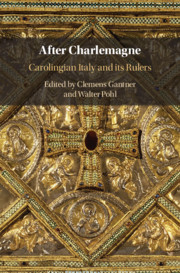Book contents
- After Charlemagne
- After Charlemagne
- Copyright page
- Contents
- Contributors
- Additional material
- 1 Italy after Charlemagne
- 2 A Brief Introduction to Italian Political History until 875
- Section I Was There a Carolingian Italy?
- Section II Organizing Italy
- Section III Carolingian Rulers
- Section IV Cities, Courts and Carolingians
- 12 A Byzantine Cuckoo in the Frankish Nest?
- 13 Urbanism as Politics in Ninth-Century Italy
- 14 Rome and the Others
- 15 Between the Palace, the School and the Forum
- Bibliography
- Index
13 - Urbanism as Politics in Ninth-Century Italy
from Section IV - Cities, Courts and Carolingians
Published online by Cambridge University Press: 03 December 2020
- After Charlemagne
- After Charlemagne
- Copyright page
- Contents
- Contributors
- Additional material
- 1 Italy after Charlemagne
- 2 A Brief Introduction to Italian Political History until 875
- Section I Was There a Carolingian Italy?
- Section II Organizing Italy
- Section III Carolingian Rulers
- Section IV Cities, Courts and Carolingians
- 12 A Byzantine Cuckoo in the Frankish Nest?
- 13 Urbanism as Politics in Ninth-Century Italy
- 14 Rome and the Others
- 15 Between the Palace, the School and the Forum
- Bibliography
- Index
Summary
Early medieval Italy was the most densely urbanized part of western Eurasia until the eleventh century. This chapter examines the practices of urbanism in the Italian peninsula, considering the social and political implications of living in cities and how they shaped the ways of life and patterns of governance in Latin- and Greek-speaking areas of the Italian peninsula. Special consideration is paid to how the Carolingian conquest and Frankish control of parts of Italy might have challenged the roles played by cities in economic and political life in those areas. Urbanism and investment in cities were tools for Carolingian rulers of Italy and their contemporaries.
Keywords
- Type
- Chapter
- Information
- After CharlemagneCarolingian Italy and its Rulers, pp. 198 - 218Publisher: Cambridge University PressPrint publication year: 2020

